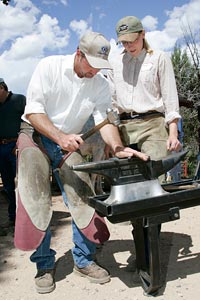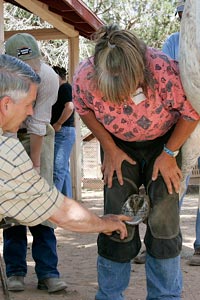Gene Ovnicek holds natural balance horseshoe workshop at the Sanctuary

Horses on tiptoe? To the untrained eye, it looked a bit like horses were being turned into ballerinas at Best Friends. But in reality, a well-known expert on natural horseshoeing taught 15 people about Natural Balance Hoof Care - a method designed to keep horses’ hooves in good shape.
Natural Balance Hoof Care workshop
Gene Ovnicek, author of "New Hope for Soundness," was invited here by Best Friends farrier Jen Reid. "I’ve been to several of Gene’s workshops and I believe strongly in it," Jen said. "Natural balance tries to address the biomechanics of the foot and to allow the horse’s body to function with the least amount of stress.

"I saw the difference it made for the horses shoed at the workshops. To me the important thing is how horses respond and how it improves their lives. Horses are not going to pretend they feel better if they don’t. When horses are stumbling, or clipping their front foot with their hind foot, or have a shortened stride, it can often be helped by changing their shoes," Jen said.
Researching wild horses' feet
Gene said he developed Natural Balance Hoof Care after extensive study of wild horses’ feet. "We noticed the wear pattern on wild horses' hooves were consistent. Then we started looking at how tamed horses’ old shoes looked after they were pulled off. We could see the shoes were worn out at the toe. We could see injuries when we looked at MRIs of the hooves."
The natural balance method sets the shoe a certain distance in front of the coffin bone in the horse’s foot, which gives it that tippy-toe look, since the hoof overlaps the shoe. But the traditional method of horseshoeing, where the shoe is flush with the hoof, doesn’t allow the horse’s foot and leg to move naturally. "It’s kind of like walking in ski boots," Jen said.
Frank Servey of Ephraim was one of the participants. "I’m a real believer in making horses feel better. This workshop reinforces what I’ve read and seen on video."

For some of the participants, the workshop at Best Friends was their introduction to the natural balance concept. Kevin Suarez of Tucson, Arizona, said he was impressed with "learning how the horse’s foot should function with the proper shoe."
Farrier education
Lisa DeFarges of St. George, Utah, said, "Jen Reid has been our farrier during the past year and she invited us to attend this clinic. The old adage ‘No hoof, no horse’ is absolutely true. I think it is wonderful that this clinic was offered at Best Friends. Education is so very important in all aspects of horse care.
"In our rural Southwest, it is often difficult to find qualified farriers. The Best Friends horse department really ‘stepped up the ramp’ by hosting this clinic to give these farriers hands-on experience with the natural balance method."
Read about Horse Haven at Best Friends Animal Sanctuary.